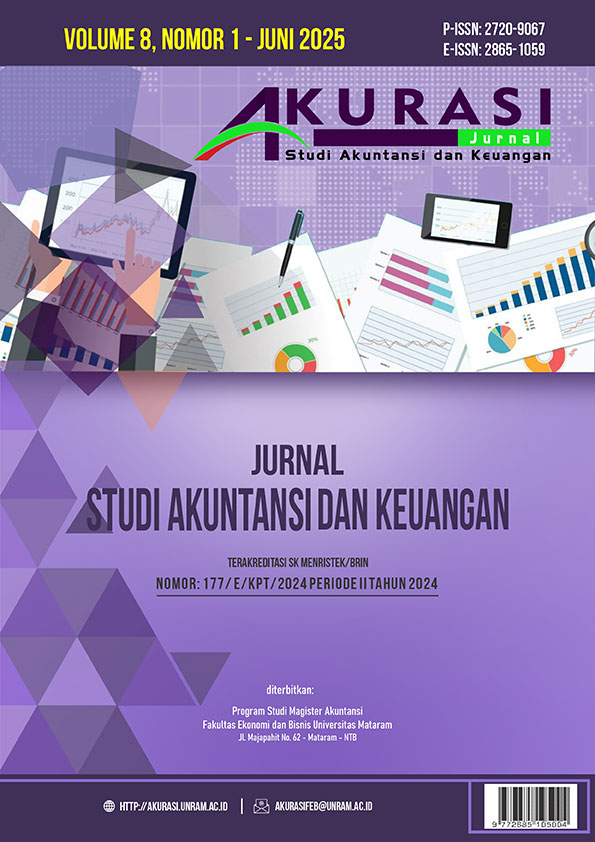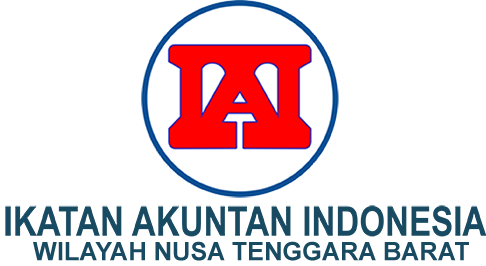CORRUPTION IN GOVERNMENT: KNOWLEDGE AND OPPORTUNITIES FOR FUTURE RESEARCH
DOI:
https://doi.org/10.29303/akurasi.v8i1.649Keywords:
accountability, corruption, government, participation, transparencyAbstract
Corruption and efforts to reduce it through the implementation of good governance have emerged as prominent topics in recent years. However, there are still diverse yet unorganized viewpoints on the concept of defining and measuring corruption. Particularly, the concept of corruption in government necessitates a more comprehensive synthesis to provide a structured overview of the existing literature and pinpoint opportunities for further advancement in this field of study. Nonetheless, previous research has made efforts in making observations to guide future research in a holistic manner. To address this issue, a systematic literature review (SLR) of 44 articles addressing good governance, including transparency, accountability, participation, and their relationship with corruption, provided a comprehensive overview synthesizing current knowledge in this domain. Specifically, it reviews the state of knowledge of the reviewed literature, identifies potential research areas, and provides recommendations to broaden avenues for future research.
Downloads
References
Andersson, S., & Bergman, T. (2009). Controlling corruption in the public sector. Scandinavian Political Studies, 32(1), 45–70.
Arkorful, V. E., Lugu, B. K., Hammond, A., & Basiru, I. (2021). Decentralization and Citizens’ Participation in Local Governance: Does Trust and Transparency Matter?–An Empirical Study. Forum for Development Studies, 48(2), 199–223. https://doi.org/10.1080/08039410.2021.1872698
Baez-Camargo, C., Bukuluki, P., Sambaiga, R., Gatwa, T., Kassa, S., & Stahl, C. (2020). Petty corruption in the public sector: A comparative study of three East African countries through a behavioural lens. African Studies, 79(2), 232–249. https://doi.org/10.1080/00020184.2020.1803729
Bertrand, Marianne, Djankov, Simeon, Hanna, Rema, Mullainathan, & Sendhil. (2006). Does corruption produce unsafe drivers? (12274).
Beshi, T. D., & Kaur, R. (2020). Public Trust in Local Government: Explaining the Role of Good Governance Practices. Public Organization Review, 20(2), 337–350. https://doi.org/10.1007/s11115-019-00444-6
Brusca, I., Manes Rossi, F., & Aversano, N. (2017). Accountability and Transparency to Fight against Corruption: An International Comparative Analysis. Journal of Comparative Policy Analysis: Research and Practice, 20(5), 486–504. https://doi.org/10.1080/13876988.2017.1393951
Canache, D., & Allison, M. E. (2005). Perceptions of Political Corruption in Latin American Democracies. Latin American Politics and Society, 47(3), 91–111. https://doi.org/10.1111/j.1548-2456.2005.tb00320.x
Chang, W. C. (2021). Corruption and perceived fairness: Empirical evidence from east asian countries. Journal of East Asian Studies, 21(2), 305–330. https://doi.org/10.1017/jea.2020.44
Cooper, H. (2010). Research Synthesis and Meta-Analysis: A Step-by-Step Approach . Sage Publications.
Cooray, A., & Schneider, F. (2018). Does corruption throw sand into or grease the wheels of financial sector development? Public Choice, 177(1–2), 111–133. https://doi.org/10.1007/s11127-018-0592-7
Crepaz, M., & Arikan, G. (2023). The effects of transparency regulation on political trust and perceived corruption: Evidence from a survey experiment. Regulation and Governance, August. https://doi.org/10.1111/rego.12555
Cucciniello, M., Porumbescu, G. A., & Grimmelikhuijsen, S. (2017). 25 Years of Transparency Research: Evidence and Future Directions. Public Administration Review, 77(1), 32–44. https://doi.org/10.1111/puar.12685
d’Agostino, G., Dunne, J. P., & Pieroni, L. (2016). Corruption and growth in Africa. European Journal of Political Economy, 43, 71–88. https://doi.org/10.1016/j.ejpoleco.2016.03.002
Dipierro, A. R., & Rella, A. (2024). What Lies Behind Perceptions of Corruption? A Cultural Approach. Social Indicators Research, 172(2), 371–391. https://doi.org/10.1007/s11205-023-03294-4
Graycar, A. (2015). Corruption: Classification and analysis. Policy and Society, 34(2), 87–96. https://doi.org/10.1016/j.polsoc.2015.04.001
Grellet, F. (1981). Developing reading skills: A practical guide to reading comprehension exercises.
Grimmelikhuijsen, S., & Welch, E. . (2012). Developing and Testing a Theoretical Framework for Computer-Mediated Transparency of Local Governments. Public Administration Review, 78(1), 562–571. https://doi.org/10.1111/puar.12047
Haddaway, N. R., Page, M. J., Pritchard, C. C., & McGuinness, L. A. (2022). PRISMA2020 : An R package and Shiny app for producing PRISMA 2020‐compliant flow diagrams, with interactivity for optimised digital transparency and Open Synthesis. Campbell Systematic Reviews, 18(2). https://doi.org/10.1002/cl2.1230
Haustein, E., & C. Lorson, P. (2022). Transparency of local government financial statements: Analyzing citizens’ perceptions. Financial Accountability and Management, 39(2), 375–393. https://doi.org/10.1111/faam.12353
He, A. J., & Ma, L. (2020). Citizen Participation, Perceived Public Service Performance, and Trust in Government: Evidence from Health Policy Reforms in Hong Kong. Public Performance and Management Review, 44(3), 471–493. https://doi.org/10.1080/15309576.2020.1780138
Heald. (2012). Why Is Transparency about Public Expenditure So Elusive? International Review of Administrative Sciences , 78(1), 30–49.
Heald, D. (2018). Transparency‐generated trust The problematic theorization of public audit. Financial Accountability & Management, 34, 317–335.
Hopper, T., Tsamenyi, M., Uddin, S., & Wickramasinghe, D. (2009). Management accounting in less developed countries: what is known and needs knowing. Accounting, Auditing & Accountability Journal, 22(3), 469–514. https://doi.org/10.1108/09513570910945697
Iyoha, F. O., & Oyerinde, D. (2010). Accounting infrastructure and accountability in the management of public expenditure in developing countries: A focus on Nigeria. Critical Perspectives on Accounting, 21(5), 361–373. https://doi.org/10.1016/j.cpa.2009.06.002
Jiang, G. (2017). Corruption Control in Post-Reform China. Springer Singapore. https://doi.org/10.1007/978-981-10-4050-4
Jin, J. (2016). Female participation and corruption in the public sector. International Review of Public Administration, 21(4), 305–319. https://doi.org/10.1080/12294659.2016.1270577
Khan, A., Krishnan, S., & Dhir, A. (2021). Electronic government and corruption: Systematic literature review, framework, and agenda for future research. Technological Forecasting and Social Change, 167, 120737. https://doi.org/10.1016/j.techfore.2021.120737
Kim, P. S. (2008). A daunting task in Asia: The move for transparency and accountability in the Asian public sector. Public Management Review, 10(4), 527–537.
Krueger, & Anne O. (1974). The political economy of the rent-seeking society. American Economic Review , 64(3), 291–303.
Lustrilanang, P., Suwarno, Darusalam, P., Rizki, L. T., Omar, N., & Said, J. (2023). The Role of Control of Corruption and Quality of Governance in ASEAN: Evidence from DOLS and FMOLS Test. Cogent Business and Management, 10(1). https://doi.org/10.1080/23311975.2022.2154060
Lyrio, M. V. L., Lunkes, R. J., & Taliani, E. T. C. (2018). Thirty Years of Studies on Transparency, Accountability, and Corruption in the Public Sector: The State of the Art and Opportunities for Future Research. Public Integrity, 20(5), 512–533. https://doi.org/10.1080/10999922.2017.1416537
Ma, J., Guo, B., & Yu, Y. (2022). Perception of Official Corruption, Satisfaction With Government Performance, and Subjective Wellbeing—An Empirical Study From China. Frontiers in Psychology, 13(July), 1–9. https://doi.org/10.3389/fpsyg.2022.748704
Mabillard, V., & Zumofen, R. (2016). The complex relationship between transparency and accountability: A synthesis and contribution to existing frameworks. Public Policy and Administration, 32(2), 110–129. https://doi.org/10.1177/0952076716653651
Malmberg, F., & Karv, T. (2022). All good in the neighbourhood ? Exploring the role of local conditions for political trust and corruption perceptions within a minority context Territory, Politics, Governance, 0(0), 1–18. https://doi.org/10.1080/21622671.2022.2071976
Mangafić, J., & Veselinović, L. (2020). The determinants of corruption at the individual level : evidence from Bosnia-Herzegovina evidence from Bosnia-Herzegovina. Economic Research-Ekonomska Istraživanja, 33(1), 2670–2691. https://doi.org/10.1080/1331677X.2020.1723426
Nation, P. (2009). Reading faster. International Journal of English Studies, 9(2), 131–144.
Neshkova, M. I., & Kalesnikaite, V. (2019). Corruption and citizen participation in local government: Evidence from Latin America. Governance, 32(4), 677–693. https://doi.org/10.1111/gove.12401
Pratolo, S., Sofyani, H., & Maulidini, R. W. (2022). The roles of accountability and transparency on public trust in the village governments: The intervening role of COVID-19 handling services quality. Cogent Business and Management, 9(1). https://doi.org/10.1080/23311975.2022.2110648
Putri, C. M., Argilés-Bosch, J. M., & Ravenda, D. (2024). Creating good village governance: an effort to prevent village corruption in Indonesia. Journal of Financial Crime, 31(2), 455–468. https://doi.org/10.1108/JFC-11-2022-0266
Rieznik, S., & Lee, H. B. (2021). Citizens’ perception of corruption and transparency as determinants of public trust in local government in Ukraine. Croatian and Comparative Public Administration, 21(2), 225–258. https://doi.org/10.31297/HKJU.21.2.2
Shleifer, Andrei, Vishny, & W., R. (1993). Corruption. Quarterly Journal of Economics, 108(3), 599–617.
Sofyani, H., Pratolo, S., & Saleh, Z. (2022). Do accountability and transparency promote community trust? Evidence from village government in Indonesia. Journal of Accounting and Organizational Change, 18(3), 397–418. https://doi.org/10.1108/JAOC-06-2020-0070
Sofyani, H., Yaya, R., & Saleh, Z. (2022). Transparency and community trust in village government: Does corruption perception matter? Financial Accountability and Management, 39(2), 1–19. https://doi.org/10.1111/faam.12351
Spyromitros, E., & Panagiotidis, M. (2022). The impact of corruption on economic growth in developing countries and a comparative analysis of corruption measurement indicators. Cogent Economics and Finance, 10(1). https://doi.org/10.1080/23322039.2022.2129368
Srirejeki, K., & Putri, P. K. (2023). Local government officials’ susceptibility to corrupt behavior: some Indonesian evidence. Journal of Financial Crime, 30(6), 1517–1533. https://doi.org/10.1108/JFC-06-2022-0132
Stamati, T., Papadopoulos, T., & Anagnostopoulos, D. (2015). Social media for openness and accountability in the public sector: Cases in the greek context. Government Information Quarterly, 32(1), 12–29. https://doi.org/10.1016/j.giq.2014.11.004
Standaert, S. (2015). Divining the level of corruption: A Bayesian state-space approach. Journal of Comparative Economics, 43(3), 782–803. https://doi.org/10.1016/j.jce.2014.05.007
Stulhofer, A., Kufrin, K., Caldarovic, O., Gregurovic, M., Odak, I., Detelic, M., & Glavasevic, B. (2008). Crime as a cultural problem, the relevance of perceptions of corruption to crime prevention. University of Zagreb, Faculty of Humanities and Social Sciences.
Su, H., Lu, Y., Lyulyov, O., & Pimonenko, T. (2023). Good Governance within Public Participation and National Audit for Reducing Corruption. Sustainability (Switzerland), 15(9), 1–17. https://doi.org/10.3390/su15097030
Svensson, J. (2005). Eight Questions about Corruption. 19(3), 19–42.
Tamsi, R. K., Zuhri, F., & Kurniasih, E. (2013). The implementation of skimming and scanning strategies in teaching reading narrative text for the tenth grade students of SMAN 21 SURABAYA. Jurnal Mahasiswa Unesa, 1(2), 1–7.
Torsello, D., & Venard, B. (2015). The Anthropology of Corruption. Journal of Management Inquiry, 25(1), 34–54. https://doi.org/10.1177/1056492615579081
Tranfield, D., Denyer, D., & Smart, P. (2003). Towards a Methodology for Developing Evidence-Informed Management Knowledge by Means of Systematic Review. British Journal of Management , 14(3), 207–222.
Uhlenbruck, K., Rodriguez, P., Doh, J., & Eden, L. (2006). The impact of corruption on entry strategy: Evidence from tele communication projects in emerging economies. Organization Science, 17, 402–414.
Ullah, M. A., Urquhart, C., Arthanari, T., & Ahmed, E. (2020). Dimensions of corruption in Pakistan: A systems thinking approach and qualitative analysis. Systems Research and Behavioral Science, 39(2), 324–338. https://doi.org/10.1002/sres.2775
United Nations General Assembly, H. R. C. (2015). Human rights council advisory committee on the issue of the negative impact of corruption on the enjoyment of human rights.
United Nations Office of the High Commissioner for Human Rights. (2018). Human rights and anti-corruption.
Vadlamannati, K. C., & Cooray, A. (2016). Transparency Pays? Evaluating the Effects of the Freedom of Information Laws on Perceived Government Corruption. Journal of Development Studies, 53(1), 116–137. https://doi.org/10.1080/00220388.2016.1178385
Vian, T. (2020). Anti-corruption , transparency and accountability in health : concepts , frameworks , and approaches frameworks , and approaches. Global Health Action, 13(1). https://doi.org/10.1080/16549716.2019.1694744
Waheduzzaman, Wahed ; Khandaker, K. (2022). E‐participation for combating corruption, increasing voice and accountability, and developing goverment effectiveness: A cross-country data analysis. Australian Journal of Public Administration, 81, 549–568.
Webster, J., & Watson, R. T. (2002). Analyzing the past to prepare for the future: writing a literature review. MIS Quar Terly, 26(2), 13–23.
Wu, S., & Christensen, T. (2020). Corruption and Accountability in China’s Rural Poverty Governance: Main Features from Village and Township Cadres. International Journal of Public Administration, 44(16), 1383–1393. https://doi.org/10.1080/01900692.2020.1765799
Xiao, H., Gong, T., & Tu, W. (2024). Why Trust Weighs More? Investigating the Endogenous Relationship Between Trust and Perceived Institutional Effectiveness. Administration and Society, 56(5), 602–627. https://doi.org/10.1177/00953997241239000
Zaitul, Z., Ilona, D., & Novianti, N. (2023). Good Governance in Rural Local Administration. Administrative Sciences, 13(1), 1–19. https://doi.org/10.3390/admsci13010019
Zhao, D., & Hu, W. (2015). Determinants of public trust in government: empirical evidence from urban China. International Review of Administrative Sciences, 83(2), 358–377. https://doi.org/10.1177/0020852315582136
Zheng, W. wen, Liu, L., Huang, Z. wei, & Tan, X. yun. (2017). Life Satisfaction as a Buffer of the Relationship Between Corruption Perception and Political Participation. Social Indicators Research, 132(2), 907–923. https://doi.org/10.1007/s11205-016-1318-1
Downloads
Published
How to Cite
Issue
Section
License
Authors who publish in Akurasi: Jurnal Studi Akuntansi dan Keuangan agree to the following terms:
- Authors retain the copyright of their articles.
- Authors grant Akurasi: Jurnal Studi Akuntansi dan Keuangan the right of first publication.
- Articles are licensed under the Creative Commons Attribution-ShareAlike 4.0 International License (CC BY-SA 4.0).
- This license allows anyone to copy, distribute, display, and adapt the articles for any purpose, including commercial use, as long as proper credit is given to the author(s) and the source, and derivative works are distributed under the same license.
- All published articles are open access and may be used for educational, research, and scientific purposes.
License: 
This work is licensed under a Creative Commons Attribution-ShareAlike 4.0 International License.







